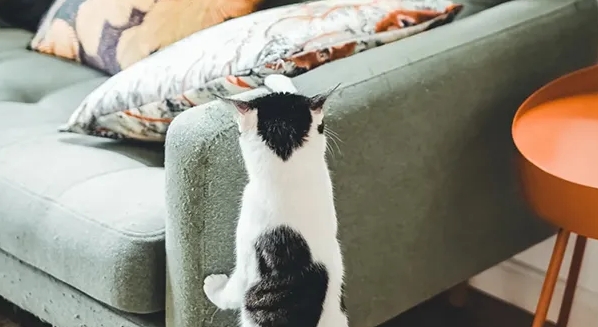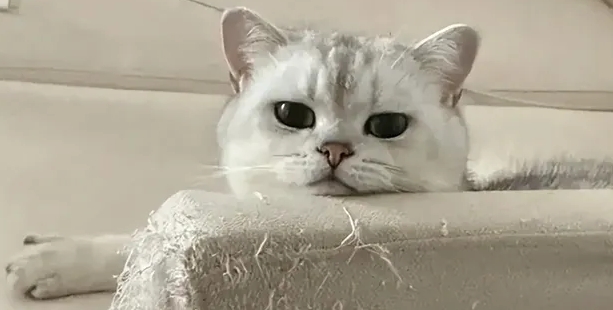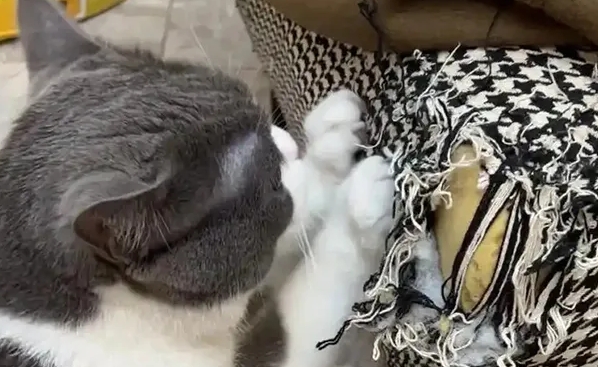Hey cat parents, one of my coworkers who has a cat recently vented his frustration.Before getting a cat, his home was a cozy, Scandinavian-style haven — soft rugs, warm decor, and a super comfy sofa.After getting a cat? He’s lucky if even one bed isn’t completely destroyed!You’ve heard the saying: “Cat owners don’t deserve nice furniture.” And honestly? It’s painfully true. There seems to be no sofa that can survive a cat’s claws.So… is being a cat parent really just accepting that your home will end up looking like a warzone? Is there any way to stop your cat from scratching the couch?
1.Why Do Cats Love to Scratch the Sofa?
①t’s a Natural Instinct
Cats scratch to sharpen and maintain their claws. A cat’s claws grow rapidly — and even faster in indoor cats. When their nails get too long or dull, it can affect their ability to hunt or even walk properly. That’s why scratching is essential: it helps them keep their claws in top condition.
② Territory Marking
Dogs mark territory by peeing everywhere (gross, but true). Cats, on the other hand, are a bit more elegant and hygienic. They use scent glands in their paws to leave their scent behind. When a cat scratches something, it’s saying, “This is mine” — through both visual marks and subtle scent cues.
③ Emotional Regulation
Scratching also serves as a form of emotional release. When a cat is stressed, anxious, or overstimulated, it may scratch to self-soothe. It helps them redirect their energy and calm down.So as cat parents, we shouldn’t try to stop scratching entirely — it’s an important part of a cat’s well-being.

2.Why Are Cats So Obsessed with Sofas?
Here are the main reasons your couch is the No.1 target:
① The texture just feels good on their paws.
Sofas often have just the right resistance and feedback — it’s claw-satisfaction heaven.
②Sofas are big and stable.
They allow your cat to stretch out fully, brace their body, and enjoy a full, luxurious scratch session.
③Your sofa smells like you.
Sofas are central in most households — a hub of human activity, family bonding, and familiar scents. For your cat, that’s irresistible.So… does being a cat owner mean you’re doomed to a forever-destroyed couch?Honestly — yes, unless you can offer a better alternative that checks all your kitty’s boxes and also makes the sofa less attractive in comparison.
3.Choose a Cat Tree Your Feline Will Actually Love
A cat tree is probably the best alternative to your sofa—but here comes the tricky part: What kind of cat tree do cats actually like?When picking a cat tree, humans often go for what looks good. But from a cat’s point of view, it’s all about how it feels when scratched. So, what makes a cat tree more attractive than your precious couch?
①Height Matters
At the very least, the cat tree should be as tall as your cat’s full body length plus stretched-out front legs. One reason cats love scratching sofas is because they can fully extend their bodies while doing it. A short, stubby cat tree just doesn’t cut it.
② Stability Is Key
Another reason sofas win? They’re sturdy. Imagine a cat scratching a wobbly cat tree—it’s not just unpleasant, it’s downright scary. Stability gives cats confidence and makes the scratching experience satisfying.

③Use the Right Material
Studies show that cats are particularly fond of corrugated cardboard and sisal fabric. You’ll also find sisal rope used in many scratchers, but here’s the catch: the coiling of the rope doesn’t always match the natural motion of a cat’s claws, making it less satisfying to scratch. So, regular sisal rope might not be your best bet.
④Offer Multi-Angled Surfaces
Another reason cats attack sofas? They offer multiple angles—vertical, horizontal, even diagonal. Most scratching boards or cat trees have only one orientation. To truly compete with the allure of the sofa, go for a multi-surface cat tree that mimics the variety of a couch.
⑤Place It in the Right Spot
Don’t shove the cat tree into some dusty corner your cat rarely visits. Place it where your cat spends most of its time—near the bed, by the sofa, or along its usual walking route. And if your cat still ignores the tree? Try sprinkling catnip on it or hanging a few dangling toys to boost its appeal.
4.Make Your Sofa Less Tempting
Is that enough to save your sofa? Not quite! Providing an alternative is just step one. You’ll also need to reduce your sofa’s appeal in your cat’s eyes.
①Avoid Fabric Sofas That Cats Love
Research shows that cats are obsessed with certain upholstery materials like chenille. These fabrics are slightly rough, allowing cat claws to hook in just right. Scratching produces satisfying resistance and visible marks—exactly what cats crave!To protect your couch, avoid fabrics that feel “perfect” to cats. Instead, choose smooth or tightly-woven materials like velvet, polyester, canvas, or microfiber suede. These have less give, making them much less fun to scratch. Will your new couch still feel cozy to sit on? That’s up to you to decide.

②Change the Sofa’s Smell
Your scent on the sofa makes it feel like home to your cat. To break this attachment, spray the couch with smells cats dislike—like menthol rubs (e.g., Tiger Balm), lemon water, or citrus essential oils. These will make your cat think twice before using the sofa as a scratching post.
After saying so much, what truly matters most for every cat parent is understanding your kitty’s natural instincts and doing your best to respect and care for those instincts.Sometimes, letting go a little—whether that means giving up on a perfectly tidy home or surrendering that old pair of slippers—isn’t necessarily a bad thing.In fact, learning when to give in, and picking your battles wisely, might just be the smartest way to live in harmony with your feline friend.

